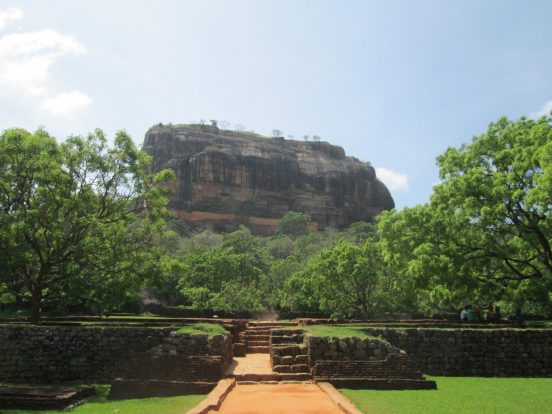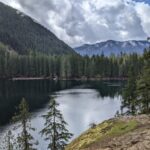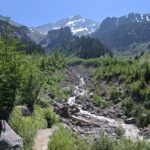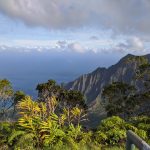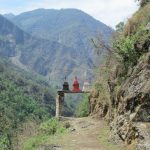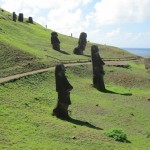From the coast we traveled inland, in a private car this time, to Sigiriya. Sigiriya is known as “the rock” because the main attraction is a huge rock that is visible from miles away towering over the area.
In the 5th century, the illegitimate son of a Sri Lankan king staged a coup, assassinated his father, drove his half brother (the heir) into exile, and built a new capital temple-palace at the top of Sigiriya Rock. The regime was overthrown and the capital returned to Anuradhapura less than two decades later, but Sigiriya remained an important Buddhist monastery until the 14th century. Today, the excavated ruins are one of Sri Lanka’s top tourist attractions.
The morning after we arrived in Sigiriya, we took the bikes provided by our guesthouse, Darshani Lodge, to the rock first after breakfast to climb before the temperature rose. We bought our tickets and walked through the gardens at the base. Then we started to climb. After a few sets of stairs we were directed to a spiral staircase to view murals of goddesses or concubines and then past a “mirror wall” that is treated to become a reflective surface using the suns rays to project images. Pretty advanced stuff for the time! Then we did the big climb up the lion’s stairway to the top.

The views were incredible the whole way but especially from the peak. We wandered around the palace ruins and took photos and relaxed by an ancient pool. The wind kept it from getting too hot. Then we descended and visited more ruins on the way back- notably a cave under a rock shaped like a cobra’s head (the cobra is sacred in Buddhism). We also saw monitor lizards and a lemur as we wandered the grounds. On the ride back we stopped for our first kotthi (roti cooked like pasta and mixed with meat and veggies- very tasty).
Later that afternoon I set out to climb “the small rock” Pidurangala. It is only 1 km from Sigiriya but I got lost on the way and had to rely on multiple locals to get me there (people in Sri Lanka are incredibly friendly!!). Although the rock is smaller, this climb is more strenuous because the last quarter of the trail requires climbing over boulders. I was red-faced and covered in sweat at the top, but the effort was rewarded by having the whole summit to myself for almost the entire time I was on it. From the peak I had a great view of Sigiriya as well as the surrounding area.

The next morning we hired the lodge’s tuk tuk to take us to Dambulla, a temple complex that includes five caves, about 20 km from Sigiriya. We spent the morning touring the temples and admiring the hundreds of Buddha statues within them. Before heading back to Sigiriya, we had some fresh juices at the cafe near the complex. In case I have neglected to mention it, Sri Lanka has incredible tropical fruit!
Chameera, our host at Darshani, drove us to Anuradhapura the next morning. Anuradhapura dates back to 380 BC and was the country’s capital and most sacred religious site for centuries. The ruins are considered to be among the top in Asia.
When we arrived at the Sacred City Guesthouse, our host, Kalum, provided us with a map of the ruins and suggested a route for us for the next day. He also told us how to get to nearby Mihintale by local bus so we decided to check it out.

The top of the hill (it seems all of Sri Lanka’s sacred sites require climbing) at Mihintale is the place where Buddhism was first introduced to Sri Lanka. After climbing over 1800 steps, we visited the stupa and sitting Buddha statue on the top of the hill. At this, and all sacred sites in Sri Lanka, visitors must remove shoes and hats and ensure their shoulders and knees are covered (carrying a sarong comes in handy as it is too hot to wear long pants).
The next morning we rented bikes from the guesthouse and began our tour of Anuradhapura. The various ruins are spread out over a few kilometers so the bikes were appreciated. The sites are in various states of restoration. Some are just piles of stones in roughly the shapes of buildings while others have been completely reconstructed. Of particular note were the two huge stupas, one red, one white, the 2000 year old bodhi tree (possibly the oldest tree in the world), and the hundreds of pilgrims wearing white- the sacred color- and leaving offerings of flowers, incense, and other objects at the various sites.

By mid afternoon, we were overheated and exhausted so we went back to Sacred City to relax. That evening we took a taxi to The Sanctuary at Tissawewa, an upscale hotel for dinner. Surprisngly, we were the only people there, but that just added to the incredible experience. We started with juices on the veranda (like many places in Sri Lanka, no alcohol was available) and then moved to the dining room for our meal. Rich had banana and chicken soup as an appetizer and devilled shrimp. I had the pork curry which came with four vegetable side dishes as well as rice, sambal and mango chutney. For dessert we had chocolate mousse. It was a truly decadent meal and was surprisingly reasonably priced. A great way to end our time in the ancient cities.
In the morning we took the train five hours to Colombo. We liked Mount Lavinia the first time so we decided to stay there again for our last two nights in Sri Lanka. For dinner we had delicious paella at a Spanish restaurant called Las Ramblas. In the morning we walked to the turtle sanctuary on the beach. Five species of turtle are found in Sri Lanka and Our Turtle Project cares for injured turtles (rehabilitating and releasing when possible) and hatches eggs and releases baby turtles into the sea. We were able to learn about all five species and see and touch four of them. Rich was in heaven!

We spent one more day exploring Colombo and Rich caught up on a few movies. Then we traveled 24 hours to Florida to celebrate my parents’ 50th wedding anniversary. Congratulations Mom and Dad!!!
